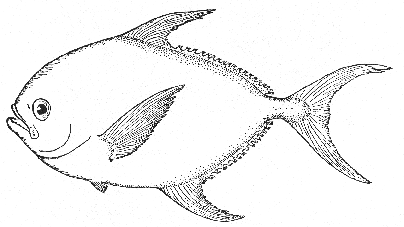Johnson's Sea Bream Taractes princeps (Johnson) 1863
[Johnson, Proc. Zool. Soc. London, 1863, p. 36.]
Description—
This sea bream is unique among Gulf of Maine fishes in its general appearance.
[page 362]In the adult the body is massive, flattened sidewise, about half as deep as it is long to the base of the tail fin. The dorsal and anal fins are long, scythe-shaped in front, each followed by a row of low rays that are detached along their outer parts, but are joined by scaly skin along their bases, giving the fins the outline shown in figure 191. The tail fin is deeply lunate; the long pectorals originate a little in advance of the dorsal, and the very small ventral fins a little in front of the pectorals. The eyes are large, oval, with vertical diameter longer than the horizontal diameter. There is no lateral line. A striking character is that the scales which clothe the vertical fins and the body (about 43 scales along the median longitudinal row) vary greatly in size, being largest along the sides, smallest on the back, breast, and fins. They vary also in shape, their exposed margins being either concave, convex, notched, or straight.
This species is separated from Brama raii Bloch 1781,[8] the only one of its relatives yet recorded from our North Atlantic coast, by its larger scales (Brama raii has 80 or more in the median longitudinal row) and by the fact that its ventral fins originate slightly, but distinctly, in front of the pectorals.
Color—
The body and head of a specimen, three days after death, were blackish, tinged with salmon on the gill covers and along the sides; the dorsal and anal fins were dusky, with the free ends of the short rays pale; the caudal was black but with its concave margin white; the pectorals were gray.
Size—
Maximum length about 3 feet.
General range—
Known only from Madeira in the eastern Atlantic, and from Browns Bank in the western.
Occurrence in the Gulf of Maine—
This fish is mentioned here on the basis of one specimen, about 33 inches long, caught on a long line on Browns Bank, off Cape Sable, in January 1928, by the schooner Wanderer. A detailed account and comparison with allied species is given by Bigelow and Schroeder.[9]
It seems certain that Taractes is very rare in American waters, at least in the depths in which commercial fishermen operate, for so conspicuous a fish would almost certainly be reported, if caught. Nothing is known of its habits except that it seems to be common around Madeira in deep water.
